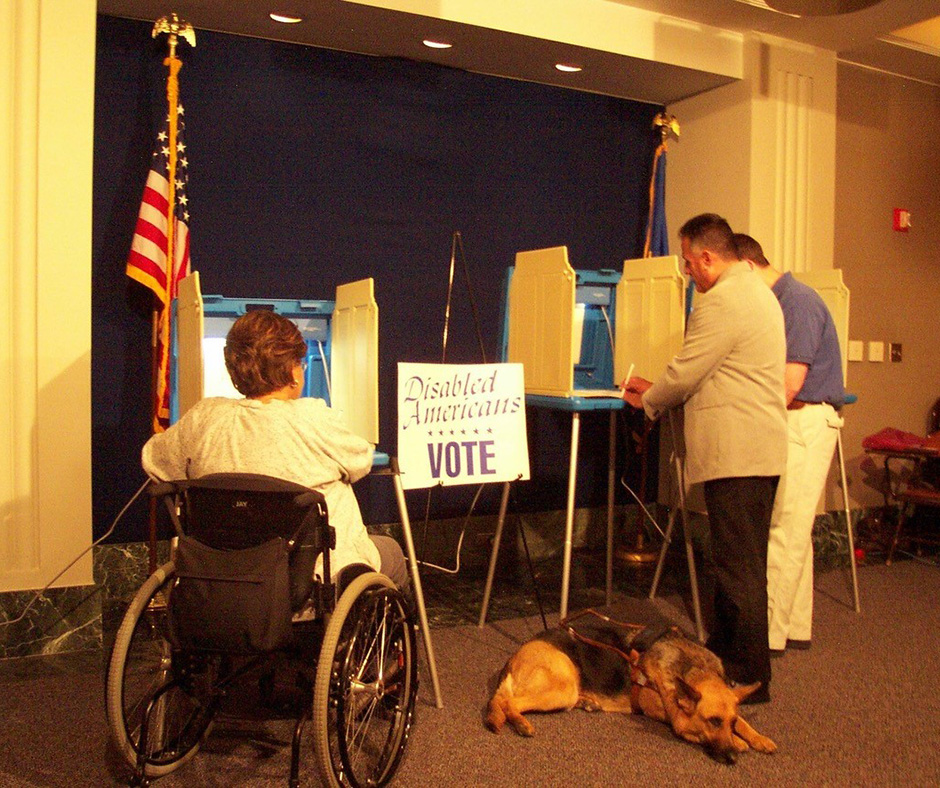 Did you know? People with disabilities make up the largest voting bloc in Minnesota. Voting is a fundamental right and a powerful way to advocate for yourself and others. Learn about the voting process and how you can cast your vote.
Did you know? People with disabilities make up the largest voting bloc in Minnesota. Voting is a fundamental right and a powerful way to advocate for yourself and others. Learn about the voting process and how you can cast your vote.
On this page:
Introduction to Voting
Our partners at the Minnesota Commission of the Deaf, DeafBlind & Hard of Hearing (MNCDHH) produced 14 videos explaining Minnesota’s voting process. The videos include information about voter registration, early voting, and voting in person. Several videos cover how to use the online tools available on the Secretary of State’s website.
The videos are narrated in ASL, with English voiceover and closed captioning. A descriptive transcript for each video is also available.
Voter Resources
The Office of the Minnesota Secretary of State offers many helpful resources for voters, including:
- Online voter registration
- Request an absentee ballot online
- Track your absentee ballot
- Sample Ballot Viewer
- Polling Place Finder
Ways You Can Vote
In addition to Election Day voting, you can vote early with an absentee ballot starting 46 days before Election Day. You can request an absentee ballot online for federal, state, and county elections. Learn more about early voting options:
- Vote early in person
- Vote early by mail
- Vote from military or abroad
- Have an agent pick up your ballot (agent delivery)
Frequently Asked Questions About Absentee Ballots
The Secretary of State’s Office answers the most frequently asked questions (FAQ) about absentee ballots. FAQ updated November 5, 2022.
Question: If I haven’t mailed it yet, what should I do with my absentee ballot?
Answer: Hand deliver it! Your ballot must be received (not postmarked) at your local county election office or ballot drop box by Election Day or it won’t be counted. If you hand deliver your ballot, return it no later than 3:00 pm. Absentee ballots will not be accepted at your polling place on Election Day.
Question: Do I need a witness to sign the signature envelope this year?
Answer: Yes! You must have a registered voter or notary witness sign the signature envelope, or your ballot won’t be counted.
Question: What about special circumstances that prevent me from voting?
Answer: You can use agent delivery! In special situations (you’re sick, hospitalized, etc.) you can have an agent pick up and return your absentee ballot for you.
Question: Can I “spoil” my absentee ballot and vote at my polling place on Election Day instead?
Answer: Yes! Poll books will show if your absentee ballot has been returned. If it hasn’t, it is considered “spoiled,” and you can still vote on Election Day.
Request an Accessible Absentee Ballot
Voters with print disabilities may request an accessible absentee ballot. Print disabilities are disabilities that interfere with the effective reading, writing, or use of printed materials.
People with print disabilities include those who:
- are blind or visually impaired;
- have learning disabilities;
- have a physical disability that interferes with holding and manipulating paper or a pen or pencil.
IMPORTANT: If you do not have a disability, you are not eligible to receive an accessible ballot.
To request an accessible absentee ballot:
- Complete the form to request an absentee ballot online.
- Once you have submitted your application, contact your local county election office and tell them that you want to receive an accessible ballot.
Polling Place Accessibility
Federal and state laws require polling places to be accessible and usable for voters with disabilities. These are the minimum requirements for polling place accessibility in Minnesota:
- If they are used to enter or leave the polling place, at least one set of doors must be at least 32 inches wide.
- Any curb adjacent to the main entrance of a polling place must have curb cuts or temporary ramps. If the main entrance is not the accessible, any curb adjacent to the accessible entrance must also have curb cuts or temporary ramps.
- If the main entrance is not accessible, a sign must be posted there giving directions to the accessible entrance.
- If they are used to enter or leave the polling place. At least one set of stairs must have a temporary handrail and ramp.
- There are no barrier in the polling place impeding the path to the voting booth.
- At least one disability parking space must be available near the accessible entrance. This space can be temporarily designated by the municipality for the day of the election
- The doorway, handrails, ramps, and disability parking must meet the standards specified in the state building code for accessibility.
A local official can only choose polling places that meet these standards, unless no available place within a precinct is accessible or can be made accessible. City and township clerks should visit polling locations periodically to check that they are accessible. The Office of the Secretary of State has a Polling Place Accessibility Diagnostic Tool (PDF) with instructions for polling place inspections.
Report a Problem with Access
Cities and towns are responsible for polling place accessibility. Contact your city or township clerk if a polling place is not accessible.
Need Assistance Voting on Election Day?
There are several ways to get assistance when you vote on Election Day. For example, you can:
- Bring someone to help.
- Ask an election judge.
- Use a machine to help you mark your ballot.
- Vote from your vehicle.
Learn more about getting assistance voting.